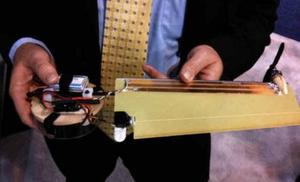SurveillanceLockheed Martin shows tiny surveillance UAV
The Samarai UAV is sixteen inches long and weighs less than half a pound; while flying, it can stream live video from a camera that rotated around its center providing a 360 degree view without a gimbal; it can be carried in a backpack and launchedt from the ground or like a boomerang

Lockheed Martin's Samarai UAV // Source: geeky-gadgets.com
Inspired by a maple seed, Lockheed Martin’s Samarai handheld vehicle flew publicly for the first time yesterday at the Association for Unmanned Vehicle Systems International conference.
Weighing less than half a pound, Samarai demonstrated vertical takeoff and landing, stable hover, and on-board video streaming. While the aircraft flew a series of flights in the roughly 40-foot test area, it streamed live video from a camera that rotated around its center providing a 360 degree view without a gimbal.
“Our team has taken the basic shape and design of the naturally aerodynamic maple seed and harnessed it with flight controls and avionics,” said Kingsley Fregene, principal investigator for Samarai at Lockheed Martin’s Advanced Technology Laboratories. “We’ve learned a great deal about biologically inspired vehicles that we can apply across the laboratory, including a better understanding of micro-robots and the devices that control their movement.”
The company says that Samarai is mechanically simple with only two moving parts. Because it is sixteen inches long and weighs less than half a pound, an operator can easily carry the vehicle in a backpack and launch it from the ground or like a boomerang.
The design is scalable to meet different missions, including surveillance and reconnaissance and payload delivery.
Lockheed Martin tested the first 3-D printed Samarai last week. The vehicle was produced by “printing” successive small layers of plastic to create a single form. The printer eliminates expensive production costs, allowing engineers to quickly and affordably produce Samarai tailored to specific missions.
